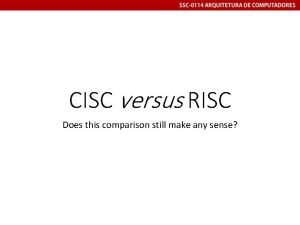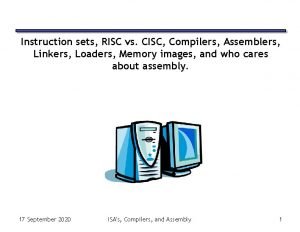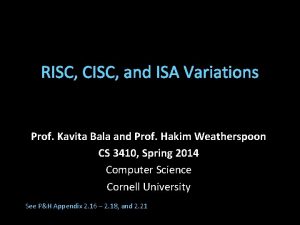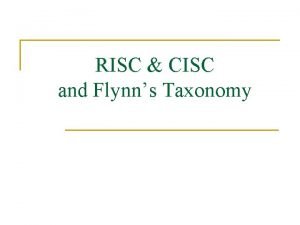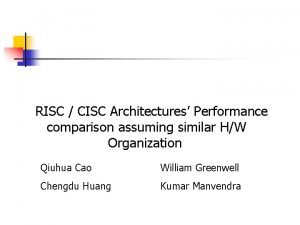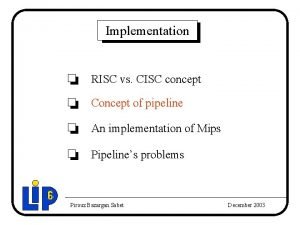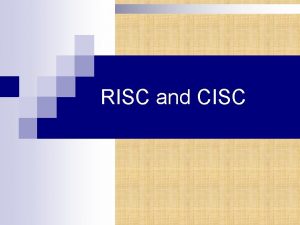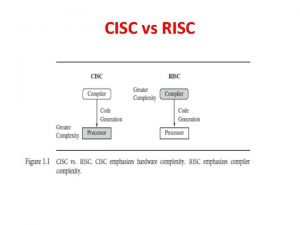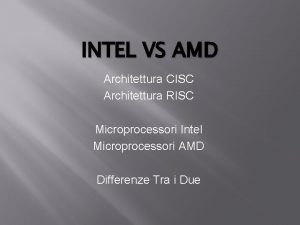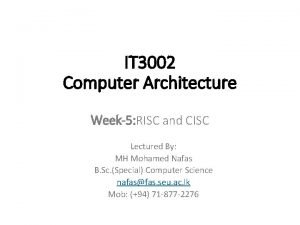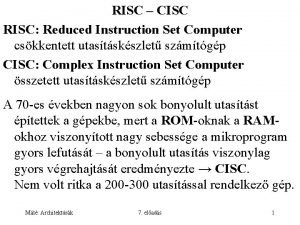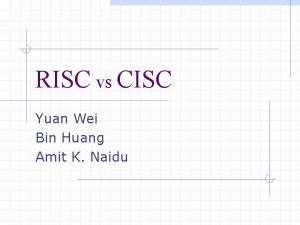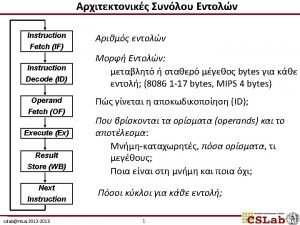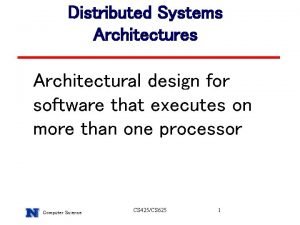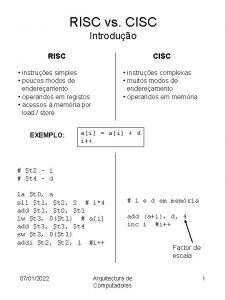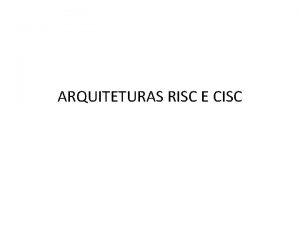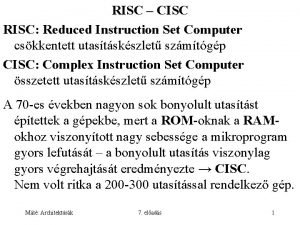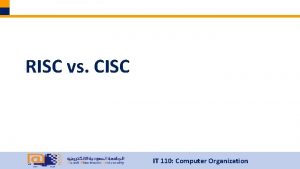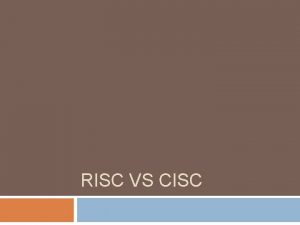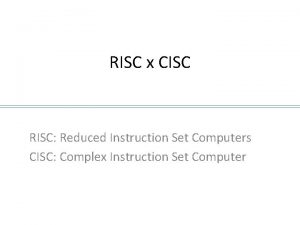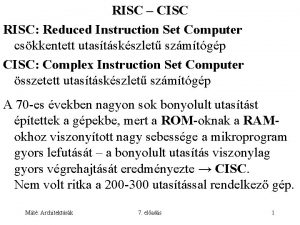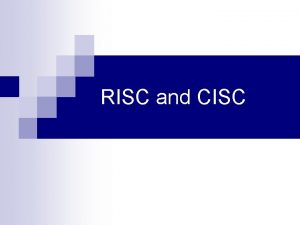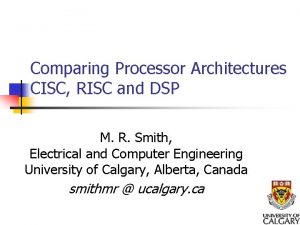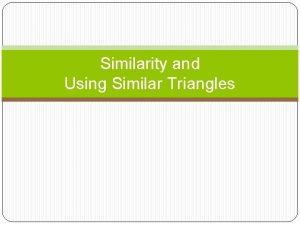RISC CISC Architectures Performance comparison assuming similar HW


































- Slides: 34

RISC / CISC Architectures’ Performance comparison assuming similar H/W Organization Qiuhua Cao William Greenwell Chengdu Huang Kumar Manvendra

Outline n n Differences between RISC / CISC Quantitative performance analysis n n n Number of Instructions Cache Behaviour Case study of one(two ? ? ) benchmarks(fp behaviour) Factors favoring RISC , CISC Critique / Conclusion

What the paper suggest? n RISC has many performance advantages over CISC n n n Single cycle L/S instruction (faster, low overhead) Hardwired control ; vastly reduced chip complexity more registers/less MEM references Fixed INST format, fewer instructions MEM accesses are not tightly bound to INSTS

Experimental Framework n Paper looks at MIPS M/2000(from RISC) and VAX 8700(from CISC) -same underlying organization n Most recent compilers were used for each of the two machines Cycle time determined through machine independent features but its same Spec 1 Release benchmarks used

CPU Pipeline Abstractions MIPS and VAX §MIPS instruction fetch stage matches with VAX microinstruction fetch stage §Large set of general purpose registers §Single cycle instructions §Delayed branches

About MIPS and VAX n Strong organizational similarities n n n Ex: CPU Pipeline abstractions match up closely VAX Microinstruction stage features a lot of RISC features MIPS has split I-Cache and D-Cache unlike VAX which has same I+D Cache MIPS has larger page size Same Cycle time -- A COINCIDENCE ? ? MIPS has much faster MEM access , FP ops

Spec Benchmarks used We have used 3 integer (in C) benchmarks § Espresso § Eqntott § Li Compiled using VAX Cv 3. 1 , CCv 2. 0 § And 7 floating point (in fortran )benchmarks § § § Spice 2 g 6 Matrix 300 Nasa 7 Fpppp Tomcatv doduc Compiled using VAX Fortran V 5. 0 -1 , MIPS f 77 v 2. 0

Tools used to generate benchmarks §VAX 8700 §Hardware monitor §Every microinstruction count is kept §Data / instruction accesses can be studied §MIPS M/2000 §Pixie/pixstats §Division into basic blocks and counting instruction in each basic blocks

n Instructions and CPI

n Instructions and CPI MIPS < VAX

n Instructions and CPI MIPS exe/ VAX exe G mean = 2. 17

n Instructions and CPI VAX CPI/ MIPS CPI G mean = 5. 77

n Instructions and CPI Net Effect on Performance cycles per program ratio

n Instructions and CPI SPICE is the best

n Three integer compilers Instructions and CPI have biggest RISC Lowest inst ratio

n Instructions and CPI Three lowest RISC three lowest CPI ratio

n Operation Counts

n MIPS per inst < VAX per inst Operation Counts MIPS also equals VAS count

n Operation Counts MIPS < VAX

n Operation Counts MIPS mem< VAX mem exception

n Cache behavior

n Cache behavior D highest miss ratio Lowest RISC factor

n Cache behavior some MIPS > some VAX

MIPS = 2. 66 × VAX

Case Study n fpppp benchmark n n Highest CPI Ratio, Highest INST Ratio, High RISC factor High number of FP L/S ops on MIPS; High density of double precision operand specifiers on VAX MIPS has fast FP operations VAX has no instruction overlapping

Architecture Factors Favoring MIPS n Operand specifier decoding n e. g. Three-register integer add n n VAX: 4 cycles ; MIPS: 1 cycle Number of Registers n n VAX: 15 32 -bit general regs MIPS: 32 32 -bit general regs and 16 64 -bit FP regs

Architecture Factors Favoring MIPS n FP Hardware/Instruction Overlap n n n Data movement between chips MIPS has register destination FP ops only Simple Jump/branches n VAX Condition codes

Architecture Factors Favoring MIPS n Fancy VAX Instructions n n n Unnecessary functionality and unnecessary overhead e. g. VAX procedure call and return inst Instruction Scheduling n MIPS can fill delay slots

Architecture Factors Favoring MIPS n Translation Buffer n n MIPS has a larger page size Branch Displacement Size n n VAX: 8 bits MIPS: 16 bits

Architecture Factors Favoring VAX Big I-stream Constants n Not-taken Branches n

Variance of the RISC Factor n Loose correlation with D-cache misses n Highest RISC factor: li n n Lowest D-cache miss ratio Lots of function call overhead for VAX Address unaligned mem refs for VAX Lowest RISC factor: spice

Future of CISC & RISC n VAX may be able to catch up to current RISC architectures. n n n Figure 4 from paper RISC will incorporate advanced implementation techniques. VAX will always play “catch up. ”

Summary Table Min Geometric Mean Max VAX CPI 5. 4 9. 9 17. 4 MIPS CPI 1. 1 1. 7 3. 1 CPI Ratio 3. 5 5. 8 10. 4 Inst. Ratio 1. 1 2. 2 3. 9 RISC-F 1. 8 2. 7 3. 7 Source: Bhandarkar & Clark. “Performance from

Caveats n n n Compiler influence may skew results. Small sample size with respect to benchmark programs Application-level vs. system-level comparison n Effect of operating system primitives
 Cisc
Cisc Risc vs cisc
Risc vs cisc Arquitectura risc y cisc
Arquitectura risc y cisc Risc vs cisc example
Risc vs cisc example Flynn's classical taxonomy
Flynn's classical taxonomy Difference between risc and cisc
Difference between risc and cisc Arduino 168
Arduino 168 Risc vs cisc
Risc vs cisc Computer organisation and architecture
Computer organisation and architecture What is cisc
What is cisc Ciri ciri risc
Ciri ciri risc Risc vs cisc vs arm
Risc vs cisc vs arm Risc, cisc
Risc, cisc Define instruction set
Define instruction set Intel risc
Intel risc Disadvantages of risc processor
Disadvantages of risc processor Risc cisc architecture
Risc cisc architecture Risc and cisc difference
Risc and cisc difference Arquitetura risc e cisc
Arquitetura risc e cisc Ecommerce site architecture
Ecommerce site architecture Aaron bannert
Aaron bannert Switched backbone
Switched backbone Why systolic architectures
Why systolic architectures Gui architectures
Gui architectures What is product architecture
What is product architecture Banking system architecture diagram
Banking system architecture diagram Autoencoders, unsupervised learning, and deep architectures
Autoencoders, unsupervised learning, and deep architectures Database system architectures
Database system architectures 3 tier data warehouse architecture
3 tier data warehouse architecture Database storage architecture
Database storage architecture Backbone network architectures
Backbone network architectures Theo schlossnagle
Theo schlossnagle Isa meaning architecture
Isa meaning architecture Cdn architectures
Cdn architectures Base system architectures
Base system architectures
